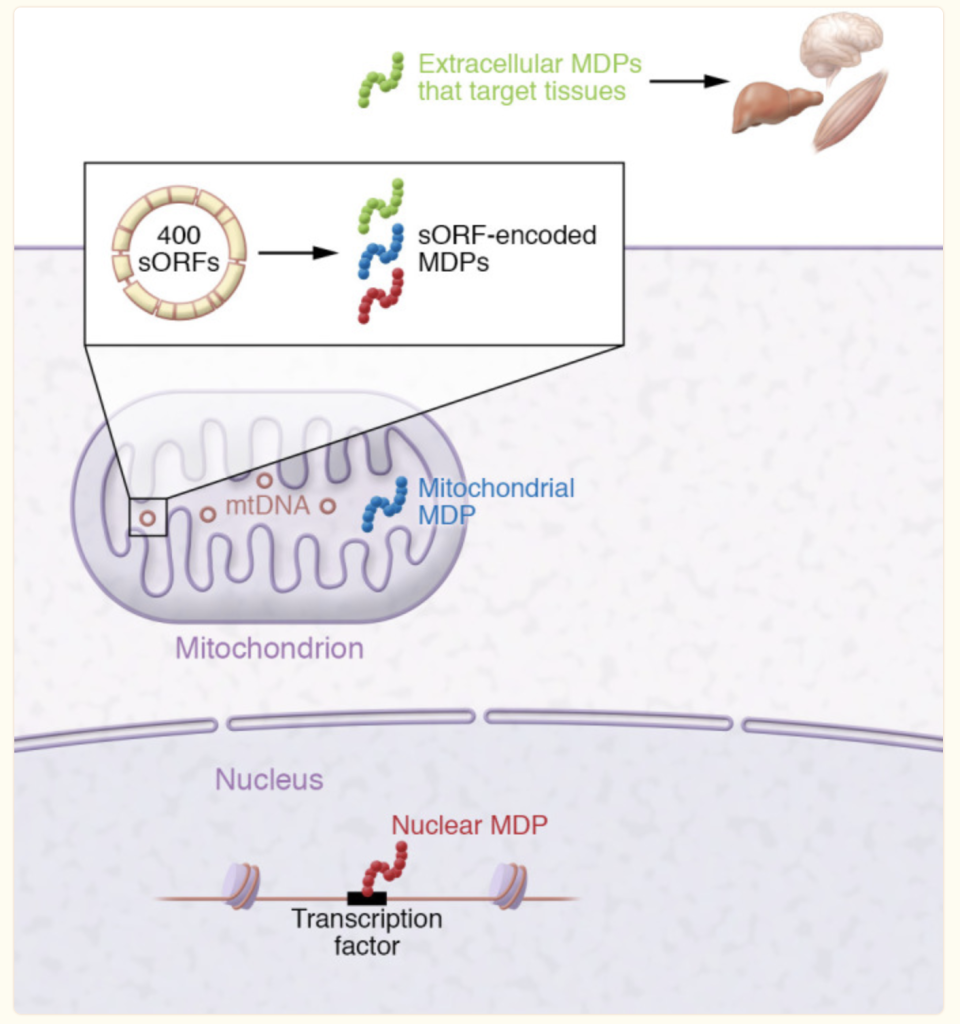MOTS-c
What is MOTS-c?
MOTS-c or M O T S-c is a peptide. But it’s considered an MDP.
MDPs are short for Mitochondrial Derived Peptides. MDPs are found inside our Mitochondria.
I’m positive we are all familiar with DNA that is found inside our cell’s nucleus, but did you know that our mitochondria actually have their own DNA?
Our mitochondria have MITOCHONDRIAL DNA known as mtDNA, which can encode various proteins and peptides just like the DNA inside our nucleus.
MDPs are mitochondrial-derived peptides, meaning they are peptides made inside of your mitochondria using their own DNA.
I always wondered why Mitochondria had a squiggly frame in my physiology book. Like a winding lake, this provides more surface area between the inner and outer membrane, and it is via this space that energy is generated to power our mitochondria and, therefore, us.
How do Mitochondria create power?
Mitochondria are considered the Powerhouse of our cells. These are our mighty mini engines inside every cell, creating ATP. Further, every cell in your body can have between 1000 and 2500 mitochondria.
ATP cannot be stored, so Mitochondria need to be making a constant supply of ATP.
How is ATP created?
The creation of ATP begins with the Electron Transport Chain or Oxidative Phosphate.
Basically, it’s a proton pump, exchanging electrons and protons between the interior matrix and into the intermembrane.
Protons in this space need to move into the matrix but can only enter through the ATP Synthase channel. They are pushed into this channel by pressure that builds up behind the inner wall membrane, like a damn.
This creates kinetic energy, which becomes ATP, powering the mitochondria to create mitochondrial-derived peptides.
Youtube video on how this intermembrane pump works to make ATP

Inside the Mitochondria matrix, there are small open reading frames sORFs. These small circles encode functional microproteins called mitochondria-derived peptides (MDPs). These MDPs can stay inside mitochondria, enter the cytosol, translocate to the nucleus, or be secreted extracellularly to target tissues.

Now we understand that our Mitochondria make ATP, how they make energy, and that MOTSc is created by sORFs inside the matrix of the Mitochondria.
How was it discovered?
MOTS-c is one of three identified MDPs.
Humanin was the first MDP discovered.
Scientists began looking at Mitochondria for aging because of its role in cellular energy and cell signaling. This is due to the mitochondrial dysfunction observed in Alzheimer’s and Parkinson’s disease. Apparently, our brain tissue is mitochondria-rich and is highly sensitive to any mitochondrial changes.
Mitochondria dysfunction is also linked to obesity, and further Cancer is linked to mitochondrial DNA instability.
As they have identified these MDPs MOTS-c has stood out.
Reserach began on MOTS-c in 2015. These small peptides made inside our Mitochondria signal different pathways and MOTS-c is special because it has been shown to mimic exercise and prevent muscle atrophy.

How does it work?
MOTS-c stands out because it communicates between the mitochondria and the nucleus. And it is encoded with mitochondrial DNA.
Researchers have found the highest levels of MOTS-c in the young and the highest concentrations of this peptide inside skeletal muscle cells.
TRANSLOCATION
When MOTS-c moves from the mitochondria to the nucleus, it activates the AMPK pathway.
AMPK is a sensor inside the nucleus that is in charge of making sure there is enough ATP.
AMPK
Once activated, AMPK increases fatty acid oxidation. This increases fat burning and glycolysis, the breakdown of sugars.
The flow of MOTS-c into the nucleus turns on energy use.
One way to stimulate the flow of MOTS-c is with exercise, and this is why higher levels are found inside skeletal muscle cells. Muscle cells require more energy.
We want AMPK initiated because it also shuts down acetyl-CoA carboxylase. This enzyme signals our body to convert triglycerides into fatty acids and store them in our liver and fat cells.
Our entire glucose breakdown and energy production begins with MOTS-c. Because the presence of MOTS-c optimizes energy, thereby optimizing our cells for production.
It’s similar to gas for your car.
This is why AMPK-triggering drugs are considered an exercise in a pill or injection.
Metformin acts as an AMPK activator but has side effects.
MOTS-c is reported to have the following benefits:
- Increases energy burning, and lowers the pool of glucose that would normally be stored.
- When AMPK is activated by MOTS-c, it stimulates the creation and clearance of new and old mitochondria, by maintaining balance and optimizing the healthiest mitochondria.
- MOTS-c Increases NAD+ levels
- MOTS-c decreases the loss of dermal collagen.
- Improves Insulin Sensity
- Improves muscle health

Hope this helps- follow me along my journey where I dose and inject inside the Natural Kaos App, we also have a large Peptide group where we share supplies and information that helps others on their peptide journey! – KIM

NATURAL KAOS APP LINKS:
ANDROID




 Healthier hair starts at the scalp!
Healthier hair starts at the scalp!

 Target the Jawline Like a Pro!
Target the Jawline Like a Pro!




